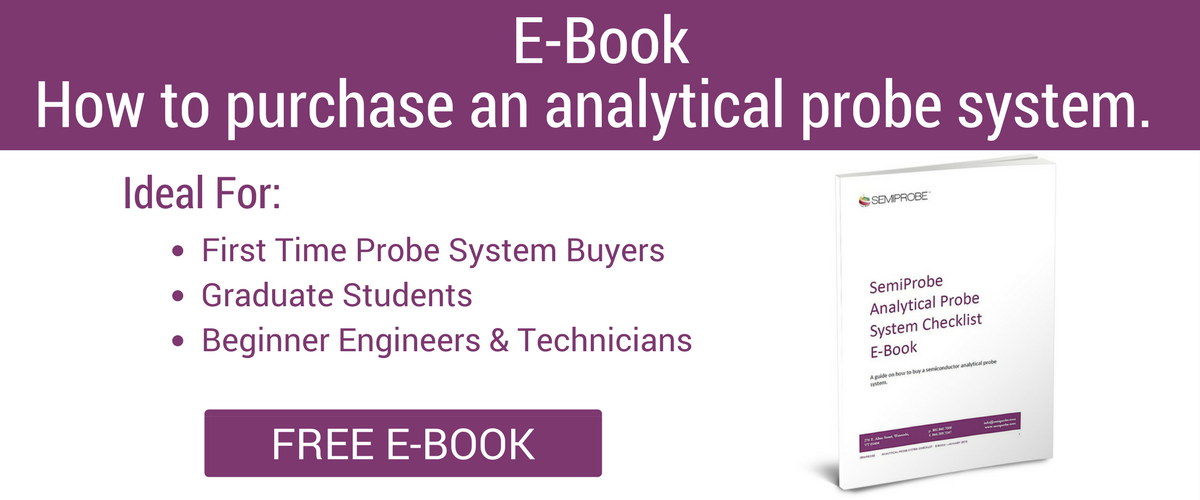You and your team are tasked with purchasing an analytical probe system, but prior to a probe system manufacturer providing you with a quote there are a series of questions that need to be answered.
There are several ways to configure a probe system and this blog reviews typical questions you need to answer to assure that you get a probe system configured to meet your application and budget.
- What type of probe system do you want?
- Manual – manual probe systems are primarily used in applications requiring measurements on a few devices (no volume), multiple configurations or multiple users with a minimum amount of probing experience. Sometimes they are selected because they are easy to set up and take data in a minimum amount of time. Manual probe systems are typically less expensive in comparison to semiautomatic systems.
- Semiautomatic – semiautomatic probe systems are primarily used in applications requiring precise movement, repeatable contacts and taking large amounts of data. For some applications they are used as a production prober. Semiautomatic probe systems are typically more expensive in comparison to manual probers but less expensive in comparison to a fully automatic prober.
- Fully Automatic – fully automatic probe systems (automatic systems) are typically used for production applications and can be operated 24 hours a day, seven days a week. Sometimes they are used to handle thin wafers, substrates, frames or trays of die. Fully Automatic probe systems are more expensive in comparison to semiautomatic and manual systems.
- What types of devices do you want to probe?
- Wafers – what size – 50 mm, 100 mm, 150 mm, 200 mm, 300 mm, other
- What is the thickness of the wafers?
- Are they flat or bowed?
- Are you probing bond pads or internal lines?
- If bond pads – what is the size?
- If lines – what size are the lines?
- Partial wafers – broken, ¼, ½, etc.
- Wafers on Frames – unsawn or sawn and stretched
- Die – individual or in a tray
- Substrates/MMICS/Carriers – rectangular
- Packaged parts
- What is the material of the devices being probed?
- Silicon
- III/V compound
- Other
- What do you want to do with the probe system?
- What is your application – Device Characterization, MEMS, High Frequency, Optoelectronics, High Power, Photovoltaics, etc.
- What types of devices are being tested – diodes, transistors, resistors, capacitors, integrated circuits, sensors, microbolmeters, etc.
- What parameters are being measured – leakage (low or high currents), breakdown voltages (low or high voltage), resistance, S-Parameters, etc.
- How to configure the probe system - key components of a probe system consist of a base, a wafer stage, a chuck, a platen, a microscope mount, a microscope movement, optics and manipulators
- What type of wafer stage is required – manual or programmable?
- What is the desired travel of the stage – 50 mm, 75 mm, 100 mm, 150 mm, 200 mm, 300 mm or more?
- What size chuck is required - 50 mm, 75 mm, 100 mm, 150 mm, 200 mm, 300 mm or more?
- What type of chuck is required – standard (non-thermal) or thermal ?
- Standard – round, square, high frequency, coaxial, triaxial
- Thermal – round, square, high frequency, coaxial, triaxial
- What temperature range is desired
- Ambient to 200 C
- Ambient to 300 C
- Ambient to 400 C
- -40 to 200 C
- -40 to 300 C
- -60 to 200 C
- -60 to 300 C
- Other – specify
- What type of platen is desired?
- Fixed – no Z movement
- Moveable – moves in Z in coarse and fine modes
- What type of optics?
- Stereozoom – used primarily for bond pad probing (50 um x 50 um to 100 um x 100 um) – provides large working distance and large field of view
- Compound – used primarily for high magnification and high resolution applications- several types available
- What type of microscope movement is required?
- Fixed (none), manual or programmable
- What type of travel range is required (X, Y and Z)
- Manual - 100 mm x 100 mm, no Z lift
- Manual - 50 mm x 50 mm with 80 mm pneumatic lift
- Manual – 100 mm x 100 mm with 80 mm pneumatic lift
- Manual - 200 mm x 200 mm with 80 mm pneumatic lift
- Programmable – 50 mm x 50 mm with 80 mm pneumatic lift
- Programmable - 100 mm x 100 mm with 80 mm pneumatic lift
- How will the device be contacted?
- With individual manipulators or a probe card?
- If manipulators – how many ?
- What type of probe arms – coaxial, triaxial, kelvin, High Frequency (HF), High Voltage (HV), or High Current (HC)?
- If probe card – what size and how many probes?
- What type of Accessories are desired?
- Vibration Isolation Table, Dark Box, CCTV System (camera and monitor), Laser Cutter System, Probe Tips ( DC or HF), Vacuum Pump, Air Compressor.
- When do you need the probe system shipped?
- Most shipments range from 6 weeks to 14 weeks after receipt of order (ARO).
- What is your budget range?
- Knowing your budget range will help the Probe System Manufacturer to configure the prober to meet your application and budget.




